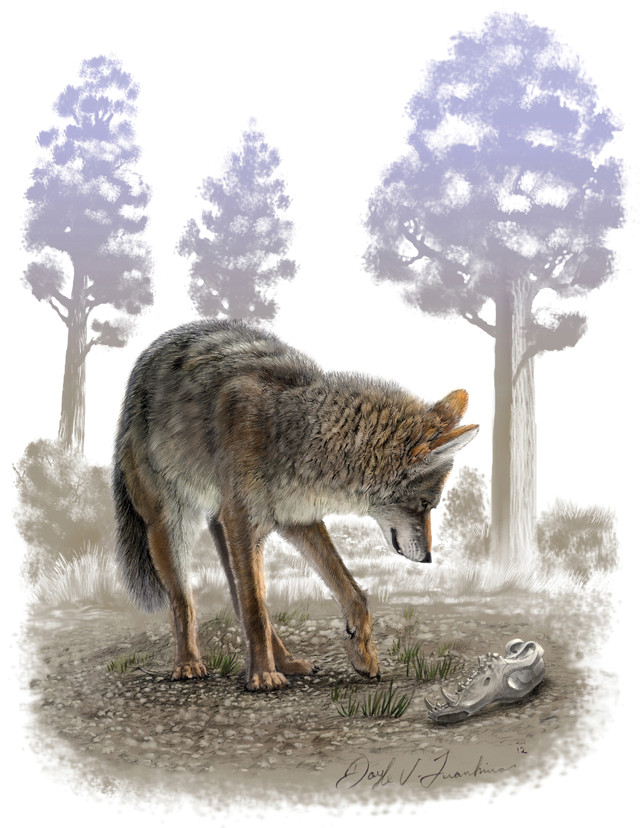
by Lucas Joel Wednesday, August 17, 2016

In this artist's illustration, a modern coyote examines the skull of a dead Pleistocene ancestor from the Rancho La Brea Tar Pits. Credit: Doyle V. Trankina (artist).
Life on Earth has endured five major mass extinctions, known as the “Big Five.” We know about these past events thanks to fossils: During mass extinctions, many species evident in the rock record disappeared from Earth relatively quickly. Today, human alteration of the environment is driving what scientists call the sixth great extinction, but according to new research, the current extinction differs from the Big Five in a key way: Much of the life facing extermination today will likely not be preserved as fossils. This means that, to future paleontologists looking at the rock record from today, the sixth extinction might not appear to have been such a major event.
“The big question is: Given what we know about the scale and timing of the ancient extinctions, how does the modern extinction compare?” says Roy Plotnick, a paleontologist at the University of Illinois at Chicago and lead author of the new study in Ecology Letters.
Compared to the Big Five, the sixth extinction, at its current extent, is “probably the smallest,” says Julie Meachen, a paleontologist at Des Moines University who was not involved in the new work. But with current extinction rates being higher now than at any other time in the last 66 million years, the sixth extinction’s magnitude will likely only continue to grow.
The Big Five extinctions are understood only through the lens of the fossil record. But humans are witnessing the sixth extinction first-hand, which means we have knowledge of which species are outgoing regardless of their chances of being fossilized. To gauge modern species’ fossilization potential, Plotnick and his team referenced the Red List of Threatened Species maintained by the International Union for Conservation of Nature (IUCN), which tracks endangered plant and animal species and categorizes them by how close to extinction they are.
The team then cross-referenced extinct and soon-to-be-extinct Red List mammals with those species’ preservation in the recent fossil record using information from databases like the Paleobiology Database and Neotoma. They found that, of the modern species considered threatened, only about 9 percent have a known fossil record, which means that the future fossil record may be just as slim.
“I don’t think anybody’s ever looked at the sixth extinction in this way before,” Meachen says. “They’ve posed the question: How would [the extinction] look in the fossil record [in the far future]? Would it actually look like a mass extinction? I would say ‘probably not.'”
Five hundred thousand years from now, to a paleontologist examining a stratigraphic section containing the sixth extinction, Plotnick says the most pronounced event would be the Pleistocene extinction, which saw the demise of iconic animals like woolly mammoths and saber-toothed cats. “You might find mammoth bones, mastodon bones, sloths,” he says. “And then above that … Boom! We would start getting [domesticated] species [like livestock]; I think that’s going to overwhelm everything else,” including most other species going extinct today. “What you’ll find is us and our beasts,” he says.
A drawback of the new study, Meachen says, is that it only considers mammals. “Maybe we can tie this in with other groups, and take a look over all fauna and see how numbers compare,” she says. Then again, many groups that could be informative — especially marine invertebrate groups like mollusks, which typically preserve as fossils in greater abundances than other animals like mammals — are relatively understudied. “They’re not sexy — the IUCN doesn’t have a [large] Red List on mollusks.” So before a study like this one could be applied to another group of animals, Meachen says, more fundamental data — on the range of species that actually exist, for example — must be added to the invertebrate sections of the Red List.
© 2008-2021. All rights reserved. Any copying, redistribution or retransmission of any of the contents of this service without the expressed written permission of the American Geosciences Institute is expressly prohibited. Click here for all copyright requests.